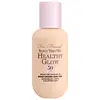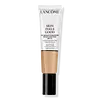Too Faced Born This Way Healthy Glow SPF 30 Moisturizing Skin Tint Versus Lancôme Skin Feels Good Tinted Moisturizer with SPF 23
What's inside
What's inside
 Key Ingredients
Key Ingredients

 Benefits
Benefits

 Concerns
Concerns

 Ingredients Side-by-side
Ingredients Side-by-side

Ethylhexyl Methoxycinnamate 5%
UV AbsorberTitanium Dioxide 3.1%
Cosmetic ColorantZinc Oxide 2.2%
Cosmetic ColorantWater
Skin ConditioningMethyl Trimethicone
Skin ConditioningPhenyl Trimethicone
Skin ConditioningSilica
AbrasiveButyloctyl Salicylate
Skin ConditioningDimethicone
EmollientNeopentyl Glycol Diheptanoate
EmollientC12-15 Alkyl Benzoate
AntimicrobialButylene Glycol
HumectantLauryl PEG-9 Polydimethylsiloxyethyl Dimethicone
Skin ConditioningEthylhexyl Palmitate
EmollientTrimethylsiloxysilicate/Dimethiconol Crosspolymer
Glycerin
HumectantPolysilicone-11
Rhododendron Ferrugineum Extract
MaskingCocos Nucifera Oil
MaskingCocos Nucifera Fruit Juice
EmollientSodium Hyaluronate
HumectantThermus Thermophillus Ferment
Skin ConditioningSodium PCA
HumectantPyrus Malus Fruit Extract
Skin ConditioningLens Esculenta Fruit Extract
Skin ConditioningCitrullus Lanatus Fruit Extract
Skin ConditioningTocopheryl Acetate
AntioxidantLitchi Chinensis Seed Extract
Skin ConditioningLecithin
EmollientSodium Lactate
BufferingTriethyl Citrate
MaskingPEG-10 Dimethicone
Skin ConditioningMagnesium Aluminum Silicate
AbsorbentDimethicone Silylate
Dextrin
AbsorbentTriethoxycaprylylsilane
Silica Dimethyl Silylate
EmollientTrimethylsiloxysilicate
EmollientDisodium Phosphate
BufferingLaureth-7
EmulsifyingDisteardimonium Hectorite
StabilisingSodium Chloride
MaskingDimethicone/PEG-10/15 Crosspolymer
Xanthan Gum
EmulsifyingCalcium Chloride
AstringentCaprylyl Glycol
EmollientDipropylene Glycol
HumectantHexylene Glycol
EmulsifyingLaminaria Saccharina Extract
Skin ProtectingGlycine Soja Protein
EmulsifyingPolyglutamic Acid
Skin ConditioningZinc Stearate
Cosmetic ColorantBHT
AntioxidantDisodium EDTA
Sodium Citrate
BufferingPhenoxyethanol
PreservativePotassium Sorbate
PreservativeSodium Dehydroacetate
PreservativeSodium Benzoate
MaskingMica
Cosmetic ColorantCI 77891
Cosmetic ColorantCI 77491
Cosmetic ColorantCI 77492
Cosmetic ColorantCI 77499
Cosmetic ColorantEthylhexyl Methoxycinnamate 5%, Titanium Dioxide 3.1%, Zinc Oxide 2.2%, Water, Methyl Trimethicone, Phenyl Trimethicone, Silica, Butyloctyl Salicylate, Dimethicone, Neopentyl Glycol Diheptanoate, C12-15 Alkyl Benzoate, Butylene Glycol, Lauryl PEG-9 Polydimethylsiloxyethyl Dimethicone, Ethylhexyl Palmitate, Trimethylsiloxysilicate/Dimethiconol Crosspolymer, Glycerin, Polysilicone-11, Rhododendron Ferrugineum Extract, Cocos Nucifera Oil, Cocos Nucifera Fruit Juice, Sodium Hyaluronate, Thermus Thermophillus Ferment, Sodium PCA, Pyrus Malus Fruit Extract, Lens Esculenta Fruit Extract, Citrullus Lanatus Fruit Extract, Tocopheryl Acetate, Litchi Chinensis Seed Extract, Lecithin, Sodium Lactate, Triethyl Citrate, PEG-10 Dimethicone, Magnesium Aluminum Silicate, Dimethicone Silylate, Dextrin, Triethoxycaprylylsilane, Silica Dimethyl Silylate, Trimethylsiloxysilicate, Disodium Phosphate, Laureth-7, Disteardimonium Hectorite, Sodium Chloride, Dimethicone/PEG-10/15 Crosspolymer, Xanthan Gum, Calcium Chloride, Caprylyl Glycol, Dipropylene Glycol, Hexylene Glycol, Laminaria Saccharina Extract, Glycine Soja Protein, Polyglutamic Acid, Zinc Stearate, BHT, Disodium EDTA, Sodium Citrate, Phenoxyethanol, Potassium Sorbate, Sodium Dehydroacetate, Sodium Benzoate, Mica, CI 77891, CI 77491, CI 77492, CI 77499
Water
Skin ConditioningGlycerin
HumectantCaprylyl Methicone
Skin ConditioningEthylhexyl Methoxycinnamate
UV AbsorberPropanediol
SolventDimethicone
EmollientRosa Gallica Flower Extract
AstringentSorbitol
HumectantTriethoxysilylethyl Polydimethylsiloxyethyl Dimethicone
Skin ConditioningDimethicone/PEG-10/15 Crosspolymer
Sodium Chloride
MaskingSodium Citrate
BufferingSodium Hyaluronate
HumectantMoringa Oleifera Seed Extract
Skin ConditioningAlumina
AbrasiveDisodium EDTA
Disodium Phosphate
BufferingIsopropyl Titanium Triisostearate
EmollientPropylene Glycol
HumectantDipropylene Glycol
HumectantCitric Acid
BufferingBHT
AntioxidantTocopherol
AntioxidantPhenoxyethanol
PreservativeChlorphenesin
AntimicrobialParfum
MaskingIron Oxides
CI 77891
Cosmetic ColorantWater, Glycerin, Caprylyl Methicone, Ethylhexyl Methoxycinnamate, Propanediol, Dimethicone, Rosa Gallica Flower Extract, Sorbitol, Triethoxysilylethyl Polydimethylsiloxyethyl Dimethicone, Dimethicone/PEG-10/15 Crosspolymer, Sodium Chloride, Sodium Citrate, Sodium Hyaluronate, Moringa Oleifera Seed Extract, Alumina, Disodium EDTA, Disodium Phosphate, Isopropyl Titanium Triisostearate, Propylene Glycol, Dipropylene Glycol, Citric Acid, BHT, Tocopherol, Phenoxyethanol, Chlorphenesin, Parfum, Iron Oxides, CI 77891
 Reviews
Reviews

Ingredients Explained
These ingredients are found in both products.
Ingredients higher up in an ingredient list are typically present in a larger amount.
BHT is a synthetic antioxidant and preservative.
As an antioxidant, it helps your body fight off free-radicals. Free-radicals are molecules that may damage your skin cells.
As a preservative, it is used to stabilize products and prevent them from degrading. Specifically, BHT prevents degradation from oxidation.
The concerns related to BHT come from oral studies; this ingredient is currently allowed for use by both the FDA and EU.
However, it was recently restricted for use in the UK as of April 2024.
Learn more about BHTCi 77891 is a white pigment from Titanium dioxide. It is naturally found in minerals such as rutile and ilmenite.
It's main function is to add a white color to cosmetics. It can also be mixed with other colors to create different shades.
Ci 77891 is commonly found in sunscreens due to its ability to block UV rays.
Learn more about CI 77891Dimethicone is a type of synthetic silicone created from natural materials such as quartz.
What it does:
Dimethicone comes in different viscosities:
Depending on the viscosity, dimethicone has different properties.
Ingredients lists don't always show which type is used, so we recommend reaching out to the brand if you have questions about the viscosity.
This ingredient is unlikely to cause irritation because it does not get absorbed into skin. However, people with silicone allergies should be careful about using this ingredient.
Note: Dimethicone may contribute to pilling. This is because it is not oil or water soluble, so pilling may occur when layered with products. When mixed with heavy oils in a formula, the outcome is also quite greasy.
Learn more about DimethiconeDimethicone/PEG-10/15 Crosspolymer is a type of silicone.
Dipropylene Glycol is a synthetically created humectant, stabilizer, and solvent.
This ingredient helps:
Dipropylene glycol is technically an alcohol, but it belongs to the glycol family (often considered part of the ‘good’ alcohols). This means it is hydrating and gentle on skin unlike drying solvent alcohols like denatured alcohol.
As a masking agent, Dipropylene Glycol can be used to cover the smell of other ingredients. However, it does not have a scent.
Studies show Dipropylene Glycol is considered safe to use in skincare.
Learn more about Dipropylene GlycolDisodium EDTA plays a role in making products more stable by aiding other preservatives.
It is a chelating agent, meaning it neutralizes metal ions that may be found in a product.
Disodium EDTA is a salt of edetic acid and is found to be safe in cosmetic ingredients.
Learn more about Disodium EDTADisodium Phosphate is a water-soluble powder used as a pH adjuster.
Ethylhexyl Methoxycinnamate is an organic compound that provides UVB protection. It often goes by the more common name of octinoxate. It is created from methoxycinnamic acid and 2-ethylhexanol.
Ethylhexyl Methoxycinnamate absorbs UVB rays with wavelengths between 280-320 nm. UV absorbers protect your skin by using chemical reactions to convert UV rays into heat and energy.
UVB (290-320 nm) rays emit more energy than UVA rays. They are capable of damaging DNA, causing sunburns and are thought to be linked to skin cancer.
The state of Hawaii has banned sunscreens containing octinoxate due to its potential impact on coral reefs. More research is needed to bridge gaps in this research. The European Union allows higher levels of octinoxate in sunscreens than the US and Australia.
Ethylhexyl Methoxycinnamate is oil soluble. It is not stable and may lose efficacy when exposed to sunlight.
Learn more about Ethylhexyl MethoxycinnamateGlycerin is already naturally found in your skin. It helps moisturize and protect your skin.
A study from 2016 found glycerin to be more effective as a humectant than AHAs and hyaluronic acid.
As a humectant, it helps the skin stay hydrated by pulling moisture to your skin. The low molecular weight of glycerin allows it to pull moisture into the deeper layers of your skin.
Hydrated skin improves your skin barrier; Your skin barrier helps protect against irritants and bacteria.
Glycerin has also been found to have antimicrobial and antiviral properties. Due to these properties, glycerin is often used in wound and burn treatments.
In cosmetics, glycerin is usually derived from plants such as soybean or palm. However, it can also be sourced from animals, such as tallow or animal fat.
This ingredient is organic, colorless, odorless, and non-toxic.
Glycerin is the name for this ingredient in American English. British English uses Glycerol/Glycerine.
Learn more about GlycerinPhenoxyethanol is a preservative that has germicide, antimicrobial, and aromatic properties. Studies show that phenoxyethanol can prevent microbial growth. By itself, it has a scent that is similar to that of a rose.
It's often used in formulations along with Caprylyl Glycol to preserve the shelf life of products.
Chances are, you eat sodium chloride every day. Sodium Chloride is also known as table salt.
This ingredient has many purposes in skincare: thickener, emulsifier, and exfoliator.
You'll most likely find this ingredient in cleansers where it is used to create a gel-like texture. As an emulsifier, it also prevents ingredients from separating.
There is much debate on whether this ingredient is comedogenic. The short answer - comedogenic ratings don't tell the whole story. Learn more about comegodenic ratings here.
The concensus about this ingredient causing acne seems to be divided. Research is needed to understand if this ingredient does cause acne.
Scrubs may use salt as the primary exfoliating ingredient.
Learn more about Sodium ChlorideSodium Citrate is the sodium salts of citric acid. In skincare, it is used to alter pH levels and acts as a preservative.
Its main functions are to maintain the pH of a product and neutralize metal ions.
The acidity of our skin is maintained by our glands and skin biome; normal pH level of skin is slightly acidic (~4.75-5.5).
Being slightly acidic allows our skin to create an "acid mantle". This acid mantle is a thin barrier that protects our skin from bacteria and contaminants.
Learn more about Sodium CitrateSodium Hyaluronate is hyaluronic acid's salt form. It is commonly derived from the sodium salt of hyaluronic acid.
Like hyaluronic acid, it is great at holding water and acts as a humectant. This makes it a great skin hydrating ingredient.
Sodium Hyaluronate is naturally occurring in our bodies and is mostly found in eye fluid and joints.
These are some other common types of Hyaluronic Acid:
Learn more about Sodium HyaluronateWater. It's the most common cosmetic ingredient of all. You'll usually see it at the top of ingredient lists, meaning that it makes up the largest part of the product.
So why is it so popular? Water most often acts as a solvent - this means that it helps dissolve other ingredients into the formulation.
You'll also recognize water as that liquid we all need to stay alive. If you see this, drink a glass of water. Stay hydrated!
Learn more about Water